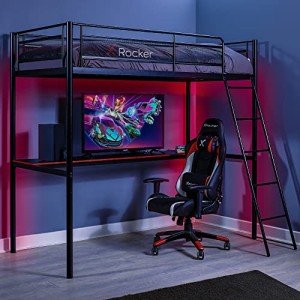Bunk Beds Sale: A Comprehensive Guide to Choosing the Right Bunk Bed for Your Home
Bunk beds have long been a staple in kids's bedrooms, offering a combination of space-saving effectiveness and fun. Whether accommodating brother or sisters, friends on slumber parties, or simply maximizing a playroom, bunk beds have actually become an essential element in contemporary family homes. As sales on bunk beds increase, it becomes progressively crucial for consumers to make educated choices when acquiring one. This article will cover the basics of acquiring a bunk bed, from types to security features, along with pointers for keeping the integrity of your financial investment.
Types of Bunk Beds
When considering a bunk bed sale, it's crucial to comprehend the different styles readily available on the marketplace. Below are the most common types:
- Traditional Bunk Beds: These consist of 2 beds stacked one above the other, sharing a single frame. They are frequently the most cost-effective option.
- L-Shaped Bunk Beds: This design features one bed positioned vertically and another horizontally. Troy Weiss produces extra space below the upper bed, which can be utilized for storage or a backyard.
- Lofted Beds: Similar to traditional bunk beds but without any lower bed. Instead, the space underneath can be utilized for a desk, play area, or additional storage.
- Triple Bunk Beds: For households with a larger number of children or regular sleepovers, triple bunk beds provide three sleeping areas in a space-efficient style.
- Futon Bunk Beds: These designs merge bunk beds and futon couches. The bottom area transforms into a separate seating location, boosting functionality.
- Convertible Bunk Beds: These beds can be separated into two private beds, making them flexible as children's needs alter over time.
Table 1: Comparison of Bunk Bed Types
| Type | Description | Space Efficiency | Extra Features |
|---|---|---|---|
| Traditional Bunk Bed | Two beds stacked vertically | High | Easiest design |
| L-Shaped Bunk Bed | One vertical and one horizontal bed | Moderate | Play or storage space |
| Lofted Bed | Raised bed with open space listed below | High | Work/play location |
| Triple Bunk Bed | Three stacked beds | Really High | Accommodates more users |
| Futon Bunk Bed | Bunk bed with a convertible futon | High | Multi-functional |
| Convertible Bunk Bed | Can be divided into two different beds | Moderate | Flexibility & & longevity |
Security Features to Consider
Security is critical when purchasing a bunk bed. Below are crucial safety features to try to find:
- Guardrails: Adequate guardrails ought to be present on both sides of the upper bunk to avoid falls. They ought to be at least 5 inches higher than the bed mattress.
- Ladder Design: Look for tough, wide ladders with slip-resistant rungs. Guarantee that the angle is not too steep for simple gain access to.
- Stability: Ensure the bed is constructed with strong materials, such as strong wood or heavy-duty metal. The bed must not wobble when in usage.
- Weight Limit: Check the weight capacity of the bunk bed to ensure it can accommodate the desired users securely.
- Product Safety: If possible, choose beds made from non-toxic materials or those satisfying safety requirements for children's furnishings.
Table 2: Essential Safety Features
| Function | Description | Value |
|---|---|---|
| Guardrails | Sides of upper bed to avoid falls | Important for kid safety |
| Ladder Design | Solid, slip-resistant rungs | Help safe and easy access |
| Stability | Construct quality to prevent wobbling | Ensures security and durability |
| Weight Limit | Optimum weight capability | Avoids accidents |
| Material Safety | Non-toxic, safe products | Protects children's health |
Maintenance Tips for Bunk Beds
To extend the life of your bunk bed and ensure ongoing safety, consider the following upkeep ideas:
- Regular Inspections: Periodically examine the structure for loose screws, bolts, or any signs of wear. Tighten up fasteners as required.
- Tidy Periodically: Dust and tidy the surfaces frequently. Use proper cleaners that will not harm the finish.
- Check Weight Limits: Be conscious of weight limitations, especially with older kids or adults who might wish to use the upper bunk.
- Prevent Climbing on Guardrails: Educate children not to use guardrails for climbing or playing to decrease the danger of accidents.
Frequently Asked Questions (FAQs)
Q1: What is the age limit for kids to safely use bunk beds?A: While it varies by the manufacturer, lots of suggest that children under six ought to not oversleep the upper bunk due to security issues.
Q2: How can moms and dads discourage risky climbing?A: Setting clear guidelines about bunk bed usage and supervising children can help. Additionally, using a bed camping tent can prevent climbing while creating a fun sleep environment.
Q3: What should I think about when embellishing a room with bunk beds?A: Ensure there suffices space around the bunk bed for safe motion, and make use of the decoration to develop individualized spaces for each child.
Q4: Is a lofted bed suitable for older children?A: Yes, lofted beds can be appropriate for older children as long as they satisfy safety requirements and the kid is responsible enough to use them securely.
Bunk beds serve a practical function while including an aspect of enjoyable to a child's bedroom. As sales of bunk beds continue to increase, cautious consideration of types, safety functions, and upkeep practices is essential for moms and dads and caregivers. By comprehending these important aspects, families can find the best bunk bed for their home, guaranteeing both usefulness and safety for several years to come. Whether it's for brother or sisters sharing a space or creating a relaxing slumber party space, a well-chosen bunk bed can supply joy and usefulness, making it a worthwhile investment.

